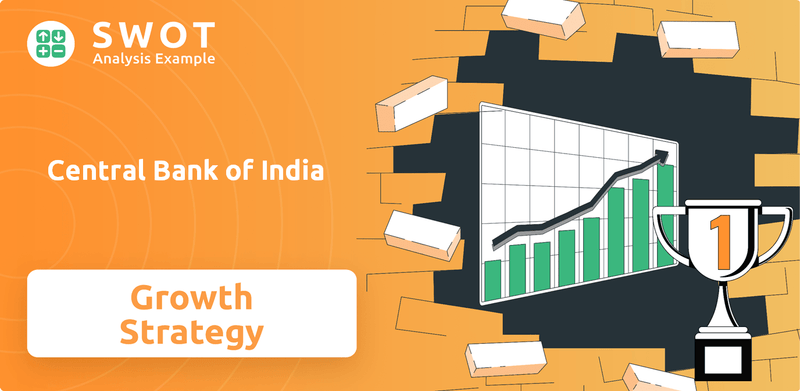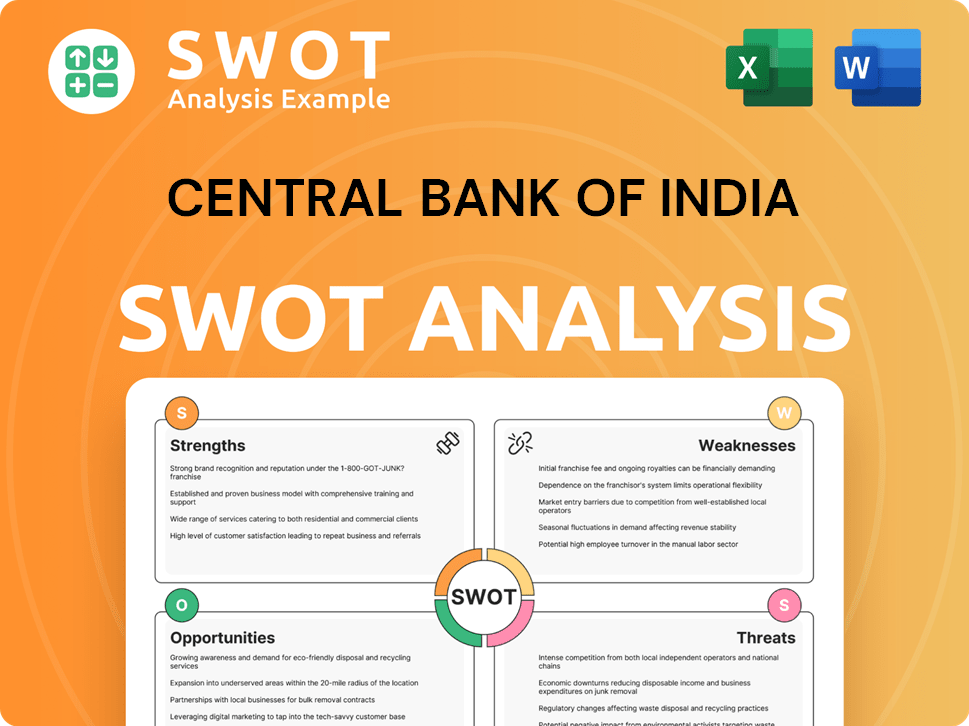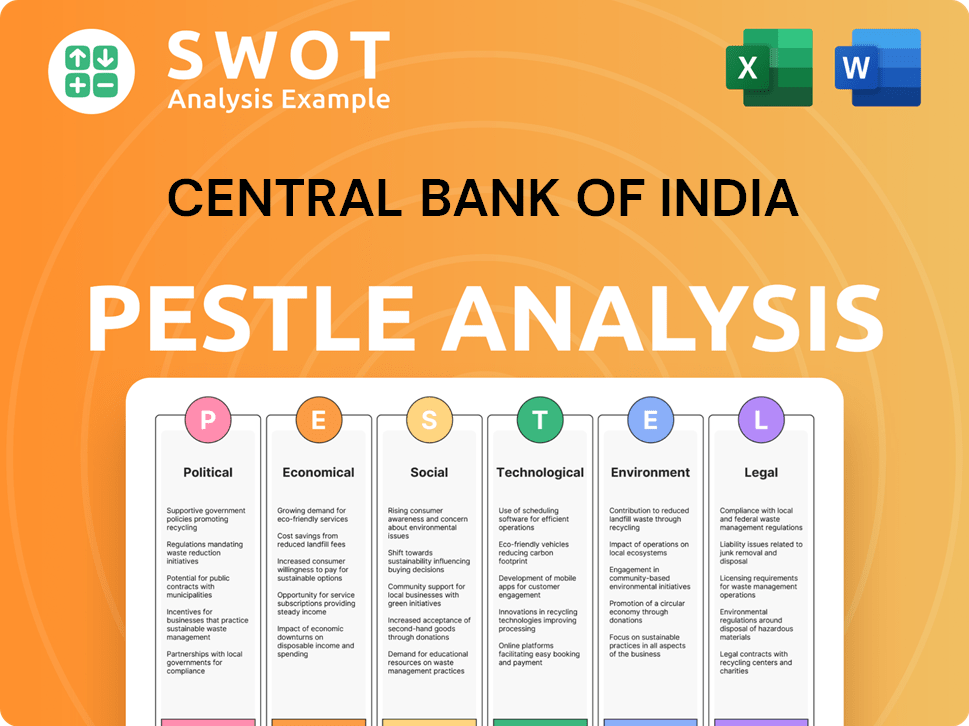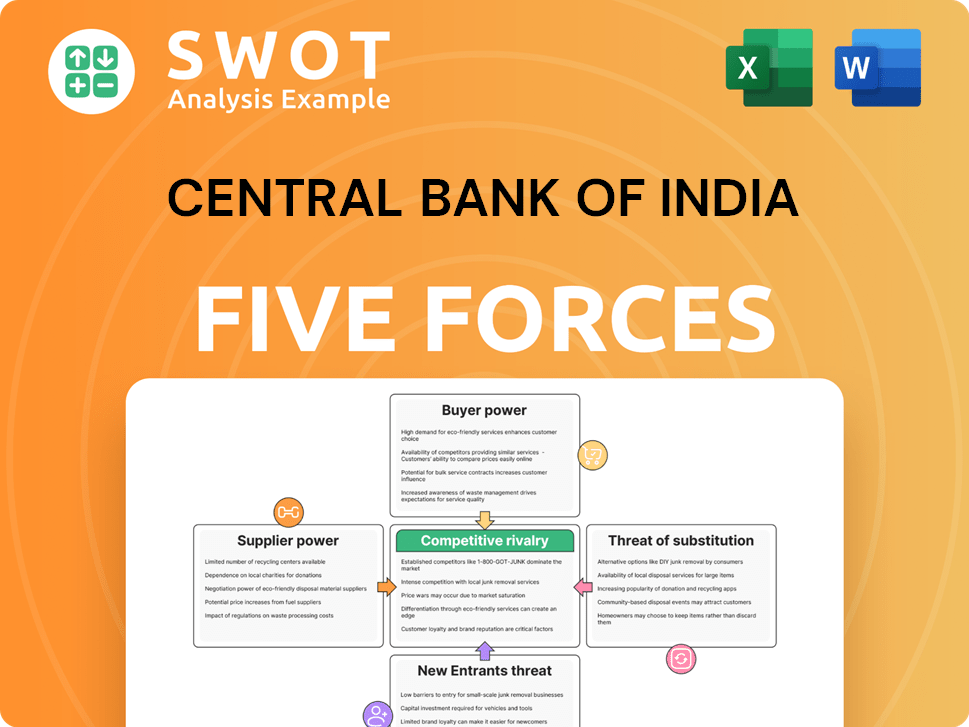Central Bank of India Bundle
Can Central Bank of India Thrive in India's Booming Economy?
Established in 1911, Central Bank of India (CBI) has a rich history as a cornerstone of the Indian banking sector. Today, as the Central Bank of India SWOT Analysis reveals, its future hinges on its ability to navigate the complexities of a rapidly evolving financial landscape. This analysis delves into CBI's growth strategy, examining its plans for expansion, innovation, and financial planning.

The Indian banking sector is experiencing dynamic shifts, making a thorough Banking sector analysis crucial for understanding CBI prospects. With the Reserve Bank of India projecting robust GDP growth, CBI has a significant opportunity to capitalize on the favorable macroeconomic environment. This exploration will uncover the strategic initiatives CBI is undertaking to enhance its market share and profitability, providing insights into CBI investment opportunities and its overall future outlook.
How Is Central Bank of India Expanding Its Reach?
The expansion initiatives of Central Bank of India (CBI) are designed to broaden its market presence and diversify its service offerings. The bank's recent performance indicates a strong focus on domestic market penetration. This is crucial for tapping into new customer segments and strengthening revenue streams within India's growing economy.
CBI's strategic moves are essential for sustained growth within the competitive Indian banking sector. These initiatives are supported by significant financial investments and strategic planning to enhance its market position. The bank is working to meet the evolving needs of its customer base.
Focusing on Revenue Streams & Business Model of Central Bank of India, CBI's expansion strategy is critical for maintaining its competitive edge. The bank's growth trajectory is closely tied to its ability to adapt to market changes and regulatory environments.
CBI reported a substantial rise in gross advances, increasing by 16.20% to ₹2,92,531 crore by March 31, 2025, compared to ₹2,51,745 crore the previous year. This growth reflects an increase in lending activities and a broader customer reach. The rise in advances indicates a proactive approach to capturing market opportunities within the Indian banking sector.
Total deposits grew by 7.18%, reaching ₹4,12,665 crore as of March 31, 2025, up from ₹3,85,011 crore. This growth in deposits highlights the bank's ability to attract and retain customers. Increased deposits provide a stable funding base for future lending and investment activities.
The bank's total business expanded by 10.75% year-on-year, reaching ₹7,05,196 crore as of March 31, 2025. This expansion includes both advances and deposits. This significant growth demonstrates the bank's strong market position and its ability to capitalize on growth opportunities.
The board approved a capital raising plan for fiscal year 2025-2026, totaling ₹5,000 crore. This will be achieved through a Follow-on Public Offer (FPO) or Rights Issue. This capital injection is essential for funding future growth through branch and ATM network expansion, or potential inorganic growth opportunities.
CBI's expansion initiatives are primarily focused on strengthening its domestic market presence. The bank is concentrating on deepening its penetration within the Indian market. The capital raising plan is crucial for supporting these strategic endeavors.
- Focus on organic expansion of its branch and ATM network.
- Exploring potential inorganic growth opportunities.
- Adapting to regulatory changes and market dynamics.
- Enhancing customer service and digital offerings.
Central Bank of India SWOT Analysis
- Complete SWOT Breakdown
- Fully Customizable
- Editable in Excel & Word
- Professional Formatting
- Investor-Ready Format

How Does Central Bank of India Invest in Innovation?
The innovation and technology strategy of Central Bank of India (CBI) is significantly influenced by the Reserve Bank of India (RBI). As a financial institution within the Indian banking sector, CBI's growth strategy is closely aligned with the RBI's digital transformation initiatives. These initiatives are designed to enhance financial services and drive growth across the banking sector.
The RBI's focus on technology and innovation creates a favorable environment for CBI. The adoption of new technologies and digital platforms is crucial for CBI's expansion plans and improving its market share. CBI's future outlook is therefore intertwined with the RBI's regulatory framework and technological advancements.
CBI's strategic initiatives are indirectly supported by the RBI's efforts. The RBI's advancements in digital payments and cybersecurity directly impact CBI's digital transformation strategy. These developments are key to understanding CBI's competitive landscape and investment opportunities.
The RBI's digital transformation efforts are recognized globally, evidenced by the Digital Transformation Award 2025. Initiatives like 'Pravaah' and 'Sarthi' have digitized internal workflows and external regulatory submissions, improving efficiency and transparency.
The RBI plans to launch a sovereign cloud in 2025, providing affordable cloud solutions to financial institutions. This will offer secure and cost-effective data storage and processing capabilities, benefiting banks like CBI.
The RBI is expanding the Central Bank Digital Currency (CBDC) pilot. By March 2025, the circulation value of CBDC grew by 334% to ₹1,016.5 crore, indicating a strong push towards a digitized financial ecosystem.
Digital payments, particularly UPI, are experiencing significant growth. UPI surpassed 13 billion transactions in a single month in March 2024, highlighting the increasing adoption of digital payment methods.
The RBI is leveraging AI/ML-based models like MuleHunter.AI to combat digital payment fraud. This showcases a commitment to integrating cutting-edge technologies for enhanced security and efficiency.
These RBI initiatives create an environment where CBI can further its digital transformation. This includes automating processes and potentially launching new digital products and platforms to contribute to its growth objectives.
The RBI's technological advancements and regulatory changes directly influence CBI's operations. This creates both opportunities and challenges for CBI.
- Cost Efficiency: The sovereign cloud initiative can reduce CBI's operational costs.
- Enhanced Security: The use of AI/ML for fraud detection enhances security.
- New Products: CBI can develop new digital products and services.
- Market Share: Digital transformation can help CBI maintain and expand its market share.
For further insights into the core values and mission of CBI, you can refer to the article on Mission, Vision & Core Values of Central Bank of India.
Central Bank of India PESTLE Analysis
- Covers All 6 PESTLE Categories
- No Research Needed – Save Hours of Work
- Built by Experts, Trusted by Consultants
- Instant Download, Ready to Use
- 100% Editable, Fully Customizable

What Is Central Bank of India’s Growth Forecast?
The financial outlook for Central Bank of India (CBI) appears robust, supported by strong performance metrics in the fiscal year 2024-2025. The bank has demonstrated significant growth in key financial areas, indicating a positive trajectory for its future. This performance is crucial for understanding the Growth strategy and future potential of CBI within the Indian banking sector.
CBI's financial results for the fourth quarter of fiscal year 2024-2025 (January-March) showcase a considerable improvement. The bank's ability to increase its profitability and manage its assets effectively is a key factor in its overall financial health. These positive indicators are essential for evaluating the CBI prospects and investment opportunities.
The bank's strategic initiatives and operational efficiency have led to these positive outcomes, positioning CBI favorably in the competitive Banking sector analysis. These improvements are crucial for the bank's long-term sustainability and expansion plans.
CBI reported a 28% increase in standalone net profit to ₹1,034 crore for Q4 FY25 compared to ₹807 crore in the same period last year. This demonstrates a strong ability to generate profits and improve financial performance. This growth is a key indicator of the bank's financial health and strategic success.
Total income for Q4 FY25 improved by 7.57% year-on-year, reaching ₹10,433 crore from ₹9,699 crore in Q4 FY24. This increase in total income reflects effective revenue generation and operational efficiency. This growth is crucial for the bank's overall financial stability.
For the entire financial year 2024-2025, the bank's net profit expanded by 48.5% to ₹3,785 crore, up from ₹2,549 crore in FY24. This significant growth underscores the bank's strong financial performance and strategic effectiveness. This is a key factor in the CBI financial performance review.
Total income for the full fiscal year rose to ₹39,521 crore from ₹35,434 crore a year ago. This increase highlights the bank's ability to generate revenue and manage its financial operations effectively. This growth supports the Central Bank of India expansion plans.
CBI's asset quality has improved, with gross Non-Performing Assets (NPAs) moderating to 3.18% as of March 31, 2025, down from 4.5% at the end of March 2024. Net NPAs decreased to 0.55% from 1.23% in the same period. The provision coverage ratio stood at 96.54% as of March 31, 2025. The bank's capital adequacy ratio improved to 17.02% from 15.08% at the end of FY24. The board has recommended a dividend of 18 paise per equity share for 2024-25. These figures underscore a strong financial narrative supporting the bank's strategic plans for future growth, with improved profitability, asset quality, and capital buffers. For more insights, consider exploring the Competitors Landscape of Central Bank of India.
Gross NPAs decreased to 3.18%, and Net NPAs decreased to 0.55%, indicating better management of loan portfolios. This improvement in asset quality is a positive sign for the bank's financial stability. This is a crucial aspect of How is CBI performing in the current market.
The provision coverage ratio stood at 96.54%, demonstrating the bank's prudent approach to managing potential losses. This high ratio indicates a strong financial buffer. This is an important factor in CBI investment opportunities.
The capital adequacy ratio improved to 17.02%, indicating a strong capital base to support future growth. This improvement ensures the bank's financial resilience. This supports the Central Bank of India market share.
The board recommended a dividend of 18 paise per equity share, reflecting the bank's profitability and commitment to shareholder value. This is a positive signal for investors. This is a key aspect of What are the challenges for CBI.
These financial results support the bank's strategic plans for future growth. The focus on profitability, asset quality, and capital buffers is central to CBI's strategic direction. This supports the CBI strategic initiatives.
The improved financial performance and asset quality position CBI favorably for sustained growth and increased market share. The bank's strong financial health supports its Central Bank of India future outlook. This is an important aspect of CBI profitability analysis.
Central Bank of India Business Model Canvas
- Complete 9-Block Business Model Canvas
- Effortlessly Communicate Your Business Strategy
- Investor-Ready BMC Format
- 100% Editable and Customizable
- Clear and Structured Layout

What Risks Could Slow Central Bank of India’s Growth?
The Central Bank of India (CBI) navigates a complex landscape of risks and obstacles that can significantly impact its growth strategy and future prospects. These challenges span market competition, regulatory changes, technological disruptions, and external economic factors. Addressing these risks is crucial for CBI to maintain its financial performance and expand its market share within the Indian banking sector.
CBI prospects are influenced by its ability to adapt to a rapidly evolving financial environment. This includes strengthening risk management frameworks, diversifying its portfolio, and proactively engaging in scenario planning. The ability to anticipate and respond to these challenges will be key to CBI's sustained growth and success.
The financial institution faces a dynamic banking landscape, requiring continuous innovation to retain and attract customers. The Reserve Bank of India (RBI) regularly adjusts its policies to ensure financial stability, which can create challenges for CBI. The RBI's focus on enhanced transparency and improved supervision, particularly for private sector banks, indirectly influences CBI's operational strategies.
The banking sector analysis reveals intense competition. CBI must continually innovate its products and services to stay competitive. This includes offering competitive interest rates, improving customer service, and leveraging technology to enhance the banking experience.
The RBI's regulatory changes pose a constant risk. CBI must adapt to new guidelines and policies to ensure compliance. This includes changes related to capital adequacy, asset quality, and risk management practices.
Technological advancements create opportunities and risks. CBI must invest in digital transformation to remain competitive. This includes enhancing digital banking platforms, improving cybersecurity measures, and adopting innovative technologies.
External factors such as global trade policies and geopolitical tensions can impact capital flows and economic stability. CBI needs to monitor these external factors. This includes assessing the impact of global economic trends on its operations and financial performance.
The rise in banking frauds presents a significant challenge. The RBI reported 36,075 fraud cases in FY24, though the amount defrauded decreased. CBI must strengthen its fraud detection and prevention mechanisms. This involves implementing advanced technologies like AI/ML-based models, as seen with MuleHunter.AI, to counter digital payment fraud and fraudulent accounts.
Supply chain vulnerabilities and climate change impacts can lead to volatility in food prices, requiring frequent monetary policy responses. CBI needs to prepare for economic fluctuations. This involves robust risk management and strategic planning.
To mitigate these risks, CBI must focus on several key areas. This involves strengthening its risk management frameworks, diversifying its portfolio to reduce exposure to specific sectors or assets, and engaging in thorough scenario planning to prepare for potential economic downturns or unforeseen events. For more insights into how CBI can improve its market presence, explore the Marketing Strategy of Central Bank of India.
Strengthening risk management frameworks is crucial. This involves implementing robust credit risk assessment models and enhancing operational risk management. CBI should regularly review and update its risk management policies to align with the latest regulatory requirements and industry best practices.
Diversifying the loan portfolio reduces concentration risk. This involves expanding into new sectors and geographies. CBI should aim to balance its portfolio across various sectors to mitigate the impact of economic downturns in specific industries.
Conducting scenario planning helps prepare for various economic outcomes. This includes stress testing the bank's financial position under different scenarios. CBI should regularly simulate potential adverse events to assess its resilience and develop contingency plans.
Investing in digital transformation is essential to stay competitive. This involves enhancing digital banking platforms and improving cybersecurity measures. CBI should prioritize the adoption of innovative technologies to improve customer service and operational efficiency.
Central Bank of India Porter's Five Forces Analysis
- Covers All 5 Competitive Forces in Detail
- Structured for Consultants, Students, and Founders
- 100% Editable in Microsoft Word & Excel
- Instant Digital Download – Use Immediately
- Compatible with Mac & PC – Fully Unlocked

Related Blogs
- What are Mission Vision & Core Values of Central Bank of India Company?
- What is Competitive Landscape of Central Bank of India Company?
- How Does Central Bank of India Company Work?
- What is Sales and Marketing Strategy of Central Bank of India Company?
- What is Brief History of Central Bank of India Company?
- Who Owns Central Bank of India Company?
- What is Customer Demographics and Target Market of Central Bank of India Company?
Disclaimer
All information, articles, and product details provided on this website are for general informational and educational purposes only. We do not claim any ownership over, nor do we intend to infringe upon, any trademarks, copyrights, logos, brand names, or other intellectual property mentioned or depicted on this site. Such intellectual property remains the property of its respective owners, and any references here are made solely for identification or informational purposes, without implying any affiliation, endorsement, or partnership.
We make no representations or warranties, express or implied, regarding the accuracy, completeness, or suitability of any content or products presented. Nothing on this website should be construed as legal, tax, investment, financial, medical, or other professional advice. In addition, no part of this site—including articles or product references—constitutes a solicitation, recommendation, endorsement, advertisement, or offer to buy or sell any securities, franchises, or other financial instruments, particularly in jurisdictions where such activity would be unlawful.
All content is of a general nature and may not address the specific circumstances of any individual or entity. It is not a substitute for professional advice or services. Any actions you take based on the information provided here are strictly at your own risk. You accept full responsibility for any decisions or outcomes arising from your use of this website and agree to release us from any liability in connection with your use of, or reliance upon, the content or products found herein.